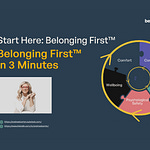What is Belonging at Work?
How you show up for your success—and the success of others
Have you ever had to put on a work mask?
Think about a time when you walked into a meeting with a decision-maker who demands agreement. You felt the need to change how you speak, calculate every word before you say it, and put all your attention into reading that person. That’s not just discomfort. That’s your brain detecting social threat.
In these environments, the brain reacts as if it’s under physical threat.
The amygdala fires. Cortisol floods your system.
Your prefrontal cortex, the part responsible for creative thinking and problem-solving, literally narrows its focus to a state of survival mode.
You stop innovating. You stop contributing. You disengage.
This isn’t about hurt feelings.
It’s the neuroscience of disengagement.
And it’s happening in workplaces every single day.
The Real Definition of Belonging
Most workplaces focus on fitting in, requiring people to adapt to feel accepted.
Belonging is different.
It’s 50/50 accountability. You anchor yourself while helping create an environment where others can do the same.
This is where the Belonging First Methodology™ comes in. It identifies five measurable indicators that show whether people can fully engage at work (Carter, 2021-2025)
The 5 Validated Indicators of Belonging:
1. Comfort
Can I show up fully, or do I shrink myself to fit in?
2. Connection
Do I feel seen, trusted, and aligned with those around me?
3. Contribution
Is my value recognized, and can I make meaningful contributions to outcomes?
4. Psychological Safety
Can I speak up without fear of judgment or retribution?
5. Wellbeing
Do I have the capacity and support to sustain performance over time?
Your 50% of the Accountability
Here’s what most people miss: belonging isn’t just about what the organization provides. It’s about how you show up: for yourself and for others.
Ask yourself:
Am I creating comfort for others—or making them shrink to survive?
Am I building connection—or defaulting to hierarchy?
Am I recognizing contribution—or overlooking value?
Am I enabling psychological safety—or reinforcing silence?
Am I supporting wellbeing—or rewarding burnout?
These questions aren’t just self-reflective. They’re relational. They measure how you anchor yourself while creating space for others to do the same.
Why This Matters for Performance
When people feel they belong, oxytocin and dopamine rise. The brain opens up to trust, collaboration, and creativity. Belonging isn’t fluffy—it’s functional. It’s the foundation for performance.
The question isn’t whether your workplace talks about inclusion. The question is: can you measure whether people actually feel they belong?
Ready to measure belonging in your workplace? Connect with our team at info@belongingfirst.com
Want to go deeper? Subscribe for actionable insights on building cultures where people perform and organizations win.
This post is part of the Start Here series introducing the Belonging First™ Methodology.
@Copyright 2025. Andrea D. Carter. Andrea Carter Consulting. Belonging First Methodology™. All Rights Reserved.







